Stopping a Promising Attack (SPA) has gone through some major changes in the past years, with disciplinary sanction changing based on the position of an offence on the Field of Play and the entity of the offence.
In this article, we will cover the basics of what defines a SPA and hopefully, give you a better understanding of the decision-making process to define the entity of a disciplinary sanction.
First, let’s look at what the Laws say about SPA
The Law gives us a clear indication that players that commit an offence which interferes with or stops a promising attack must be cautioned, unless the referee awards a penalty kick and the foul is an attempt to play the ball (footballing challenge).
This definitely helps us understand the entity of the disciplinary action, however, defining what is a promising attack is a much more difficult process which requires referees to have a strong tactical awareness and understanding football and the way teams play, as there are many factors that contribute to how we define whether a foul interferes or stops a promising attack or not.
When determining whether an offence is a SPA or not, we need to factor in a number of variables and the combination of some or all of them helps us identifying a SPA. The variables to consider are:
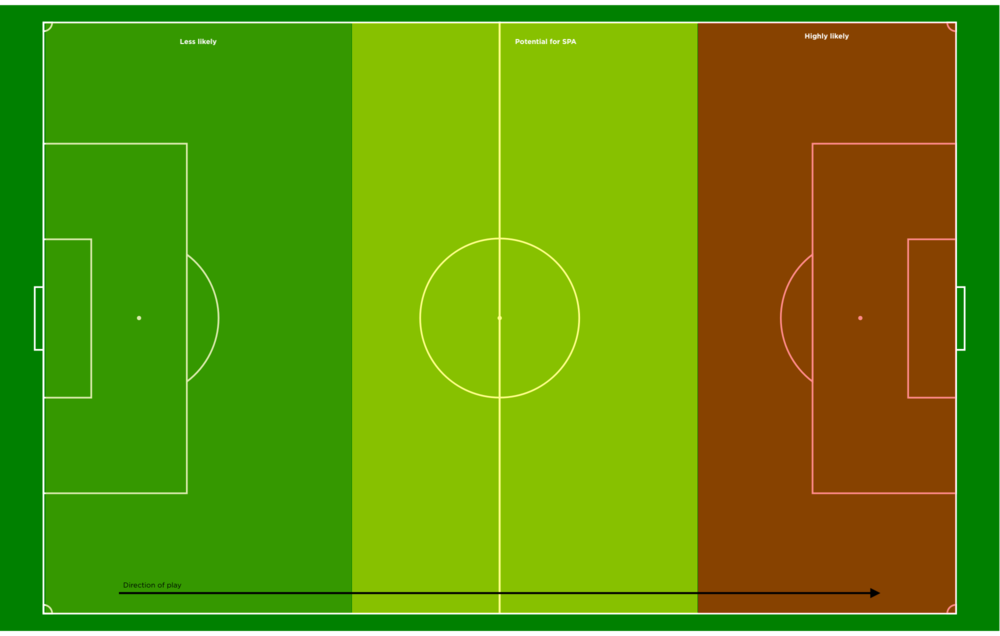
1. DISTANCE FROM GOAL
How far is the offence from the opponents’ goal? Usually, the closest we are the more likely an attack can be considered promising, with some exceptions determined by the other criteria.
The image below show how tactically it is more likely that a foul will stop a promising attack in the red or yellow area. Keeping in mind this can help a referee considering a SPA even before it happens, knowing that these two are the “hot areas” for SPA.
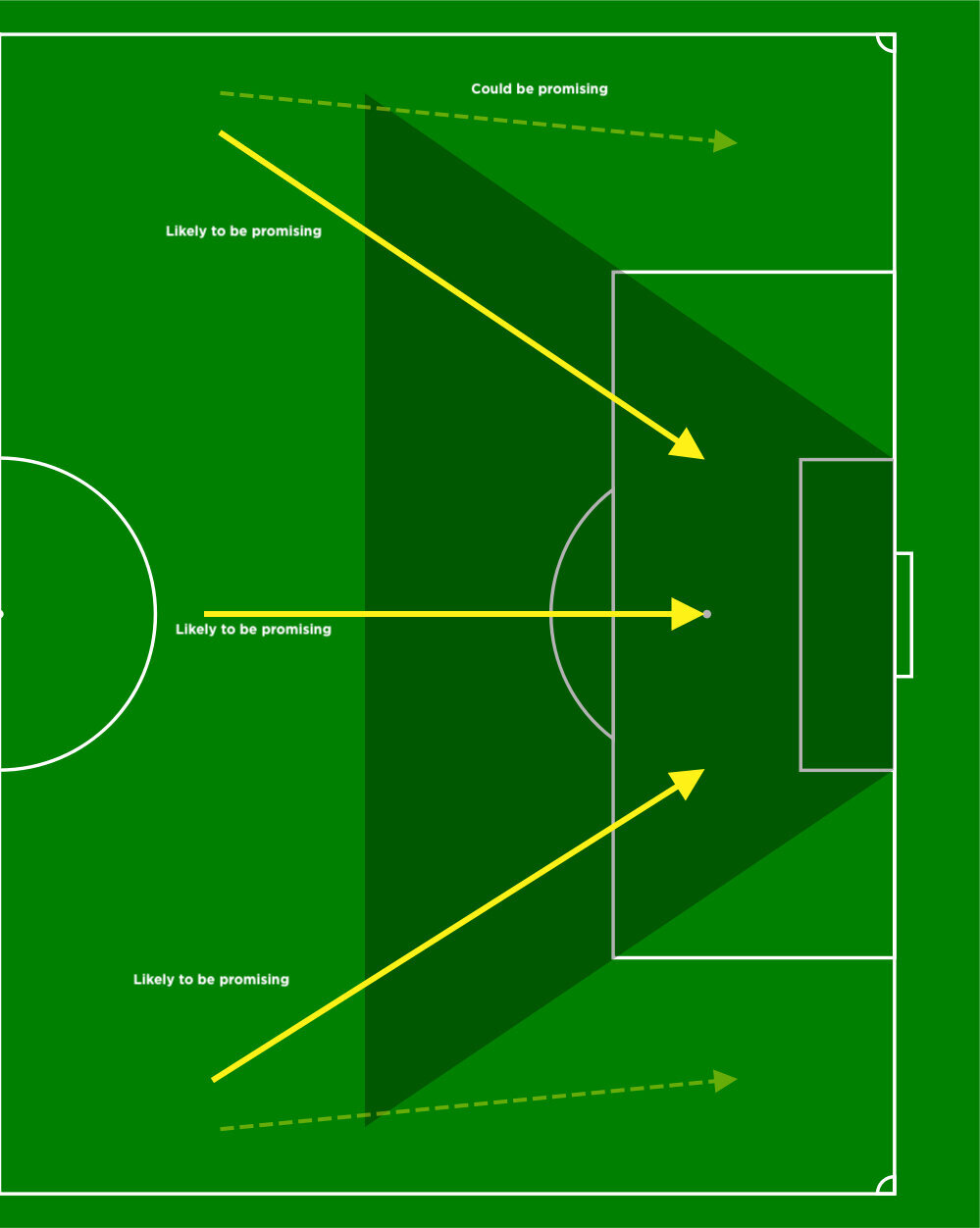
2. DIRECTION OF PLAY
The second factor to consider to determine if a foul is SPA or not is the direction of play. What we need to consider is whether or not the attack is going towards the opponents’ goal or not. Usually, if a player has their shoulder facing the opponents’ goal means that the attack is not promising as the attacking player that gets fouled is not even facing the goal.
As always, there are exceptions. If a player has their shoulders facing the goal but has dribbled past all defenders and goalkeeper and there is no one to challenge him, obviously this must be considered at least as a promising attack, if not an obvious goal scoring opportunity. This image sums up the most common scenarios where a yellow card for SPA could be awarded
3. POSSESSION OR LIKELIHOOD TO GAIN POSSESSION OF THE BALL
This is a key aspect of SPA. Without possession or the likelihood of an attacker to gain possession of the ball when the offence occurs, there can be no SPA. Let’s be really clear, the foul still stands and if the offence requires any disciplinary sanction, like a reckless tackles, a card should still be awarded, simply not for SPA.
This point speaks for itself, if a player that is fouled doesn’t have possession of the ball or is not likely to gain possession when the offence occurs all other factors don’t matter anymore.
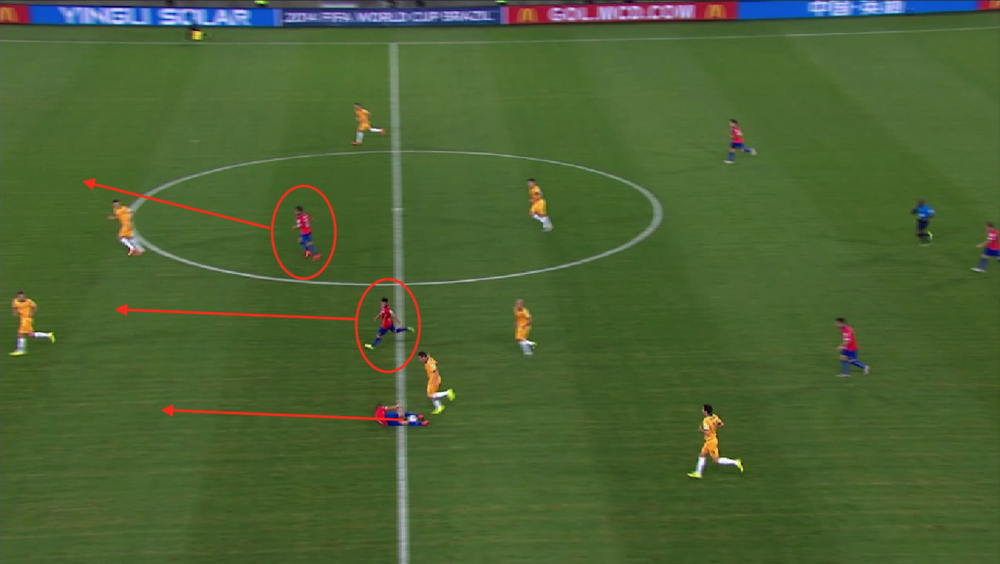
4. NUMBER AND POSITION OF THE ATTACKERS
When considering the number and position of the attackers, referees should try and understand how are they participating to the action and if they are offering more options to the teammate who has possession of the ball to create potential threats to their opponents.
In this example the red player that gets fouled had two teammates running up the field with him creating numerical superiority on their opponents and offering the ball carrier two passing options for him to use once they got in or close to the penalty area.
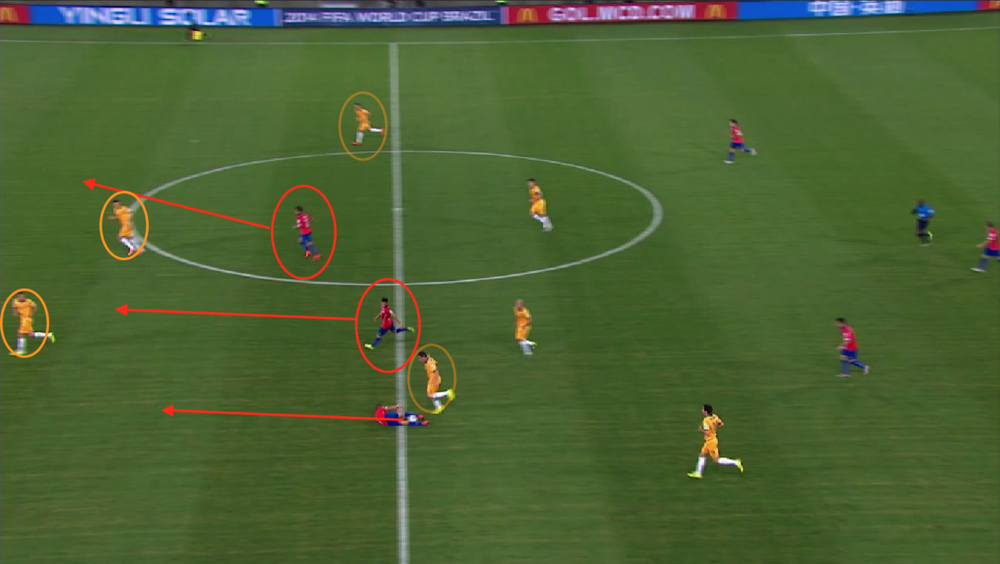
5. NUMBER AND POSITION OF DEFENDERS
Last but not least consideration is the number and the position of the defenders. This helps up identifying correctly a SPA as the more defenders are able to challenge their opponents, the less likely the attackers will be to create a threat to the defence.
Using the same example as before, we can see how there is only 2 defenders that can actively challenge the ball carrier and his teammates when the offence occurs. The offender was behind his opponent before tripping him down and there is another defender on the far side of the pitch that is, however, too far to impact the attackers and stop their threat.
These are the factors to consider to correctly identify a SPA. As mentioned above, not all of these considerations need to be true for a SPA to be awarded, but a combination of these can be enough to consider an attack promising.
However, once we’ve identified a SPA it is not necessarily a yellow card if, and only if, the offence occurred in the penalty area resulting in a penalty kick and the foul was an attempt to play the ball.
Once we have decided that the offence has stopped a promising attack, the first question we must ask ourselves is:
Did the offence happen in the penalty area?
If the answer is no our life is much easier, as the LoTG states that all SPA offences outside the penalty area must be punished with a yellow card.
In this example the blue defender carelessly trips an orange attacker. The direction of play is towards goal, the distance is approximately 25 m, there are 2 orange attackers as a passing option for the fouled player who could have taken a shot as well if he wasn’t tripped and the ball carrier was highly likely to keep possession of the ball. This is a SPA, the offence occurred outside the penalty therefore this is always a yellow card, despite the offence being a footballing challenge.
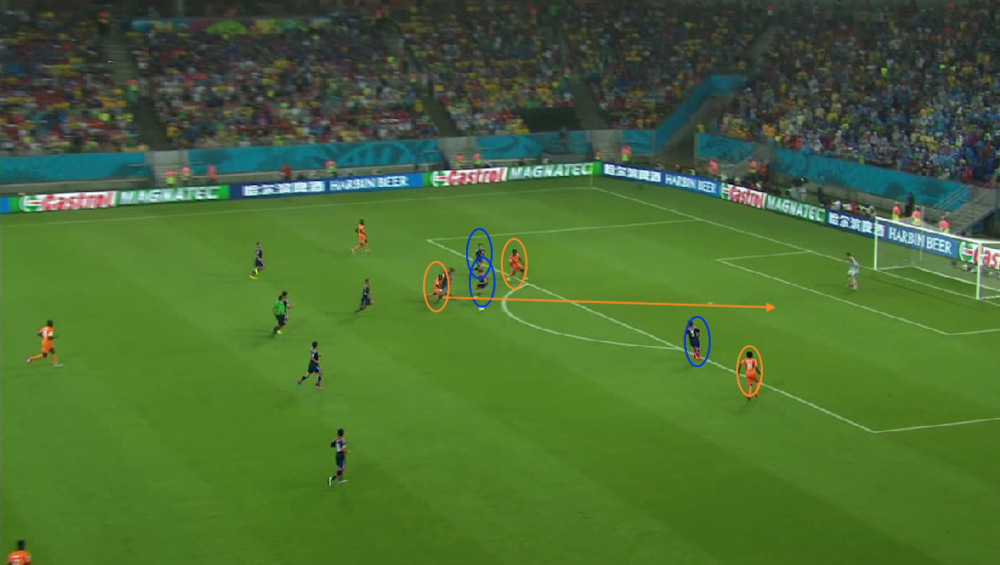
If the answer is yes, then we need to judge whether the challenge was an attempt to play the ball or not. If the offence is a hold, pull, push or a handball then it will never be considered a footballing challenge as none of those constitutes an attempt to fairly challenge the opponent.
In this example number 3 red put his hand up high meaning this handball must be punished with a penalty kick. Since this is considered as a shot on goal this is a SPA, and since the offence is a handball and not a footballing challenge the referee correctly awarded a penalty kick and yellow card.
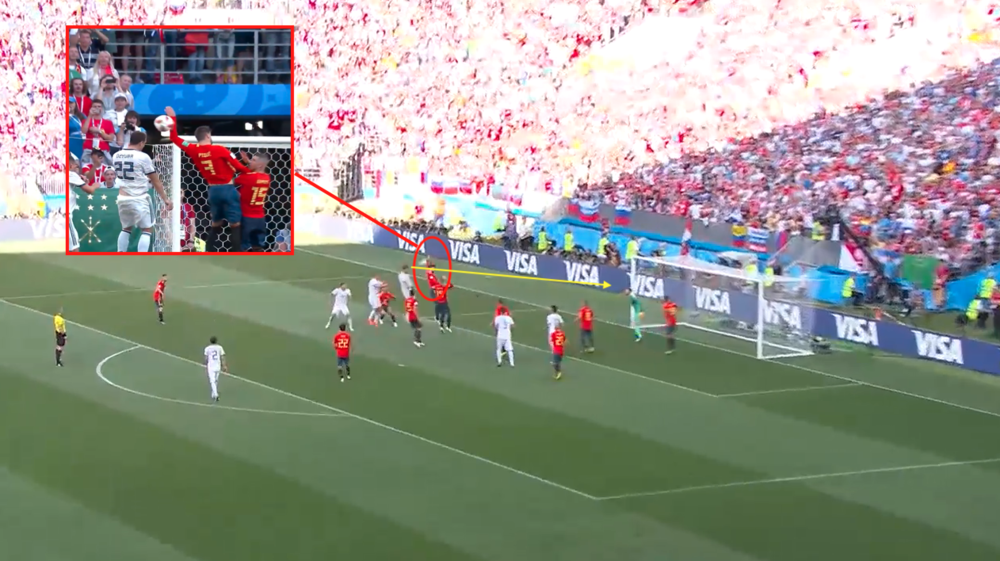
This is another example of non-footballing challenge. The red defender clearly pulls the gold attacker’s shirt when he’s about to take a header towards goal. A penalty and yellow card for SPA must be awarded in this scenarios.
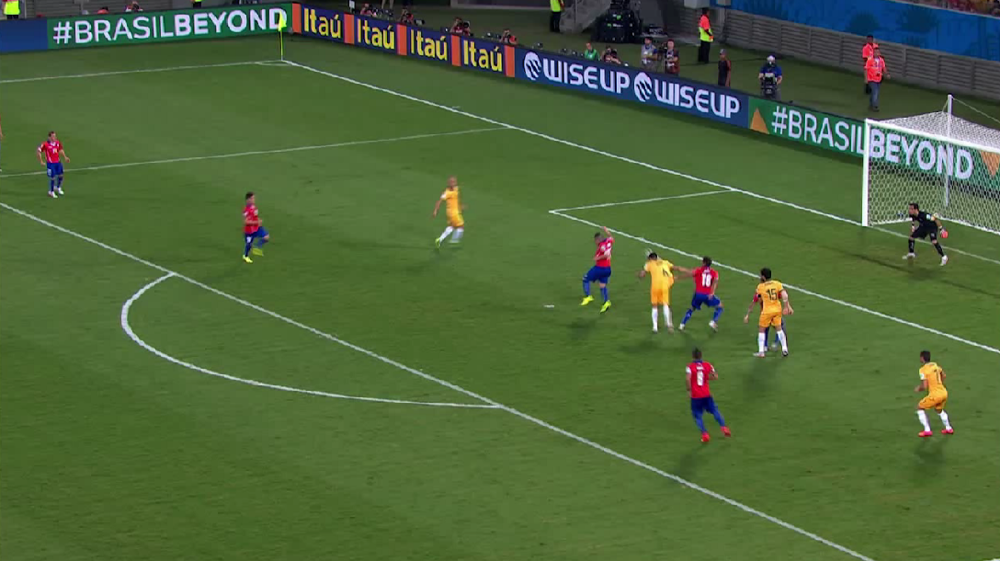
In this example, you can see how the blue player carelessly trips his opponent. The distance is really close, just within the penalty area, the attacker is moving horizontally, however, it is still moving into a dangerous area as he would have regained possession of the ball slightly behind the penalty spot. The presence of number 15 blue makes this a promising attack and not an obvious goal scoring opportunity, as if he didn’t get tripped that would have created a 1 on 1 with a blue defender with the defending goalkeeper ready to save the ball in his goal. As this foul was a clear attempt by the blue defender to play the ball that resulted in a penalty kick, this SPA must not be punished with a yellow card, but only with the kick from the spot.
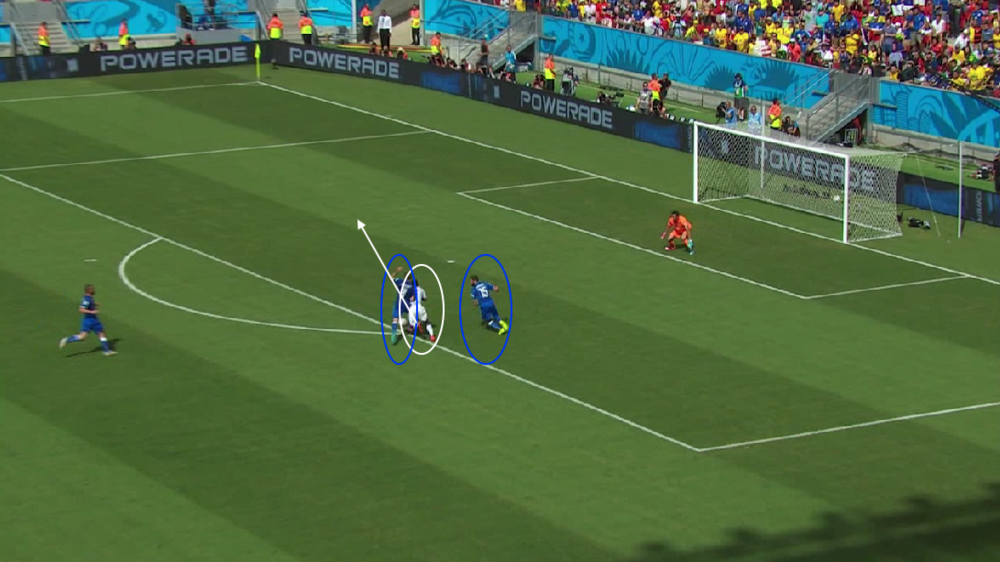
Permalink
Continue reading...
In this article, we will cover the basics of what defines a SPA and hopefully, give you a better understanding of the decision-making process to define the entity of a disciplinary sanction.
First, let’s look at what the Laws say about SPA
Law 12 - Fouls and Misconducts
CAUTIONS FOR UNSPORTING BEHAVIOUR
There are different circumstances when a player must be cautioned for unsporting behaviour including if a player:
[…]
- commits a foul which interferes with or stops a promising attack, except where the referee awards a penalty kick for an offence which was an attempt to play the ball
[…]
The Law gives us a clear indication that players that commit an offence which interferes with or stops a promising attack must be cautioned, unless the referee awards a penalty kick and the foul is an attempt to play the ball (footballing challenge).
This definitely helps us understand the entity of the disciplinary action, however, defining what is a promising attack is a much more difficult process which requires referees to have a strong tactical awareness and understanding football and the way teams play, as there are many factors that contribute to how we define whether a foul interferes or stops a promising attack or not.
When determining whether an offence is a SPA or not, we need to factor in a number of variables and the combination of some or all of them helps us identifying a SPA. The variables to consider are:

1. DISTANCE FROM GOAL
How far is the offence from the opponents’ goal? Usually, the closest we are the more likely an attack can be considered promising, with some exceptions determined by the other criteria.
The image below show how tactically it is more likely that a foul will stop a promising attack in the red or yellow area. Keeping in mind this can help a referee considering a SPA even before it happens, knowing that these two are the “hot areas” for SPA.

2. DIRECTION OF PLAY
The second factor to consider to determine if a foul is SPA or not is the direction of play. What we need to consider is whether or not the attack is going towards the opponents’ goal or not. Usually, if a player has their shoulder facing the opponents’ goal means that the attack is not promising as the attacking player that gets fouled is not even facing the goal.
As always, there are exceptions. If a player has their shoulders facing the goal but has dribbled past all defenders and goalkeeper and there is no one to challenge him, obviously this must be considered at least as a promising attack, if not an obvious goal scoring opportunity. This image sums up the most common scenarios where a yellow card for SPA could be awarded
3. POSSESSION OR LIKELIHOOD TO GAIN POSSESSION OF THE BALL
This is a key aspect of SPA. Without possession or the likelihood of an attacker to gain possession of the ball when the offence occurs, there can be no SPA. Let’s be really clear, the foul still stands and if the offence requires any disciplinary sanction, like a reckless tackles, a card should still be awarded, simply not for SPA.
This point speaks for itself, if a player that is fouled doesn’t have possession of the ball or is not likely to gain possession when the offence occurs all other factors don’t matter anymore.

4. NUMBER AND POSITION OF THE ATTACKERS
When considering the number and position of the attackers, referees should try and understand how are they participating to the action and if they are offering more options to the teammate who has possession of the ball to create potential threats to their opponents.
In this example the red player that gets fouled had two teammates running up the field with him creating numerical superiority on their opponents and offering the ball carrier two passing options for him to use once they got in or close to the penalty area.

5. NUMBER AND POSITION OF DEFENDERS
Last but not least consideration is the number and the position of the defenders. This helps up identifying correctly a SPA as the more defenders are able to challenge their opponents, the less likely the attackers will be to create a threat to the defence.
Using the same example as before, we can see how there is only 2 defenders that can actively challenge the ball carrier and his teammates when the offence occurs. The offender was behind his opponent before tripping him down and there is another defender on the far side of the pitch that is, however, too far to impact the attackers and stop their threat.
These are the factors to consider to correctly identify a SPA. As mentioned above, not all of these considerations need to be true for a SPA to be awarded, but a combination of these can be enough to consider an attack promising.
However, once we’ve identified a SPA it is not necessarily a yellow card if, and only if, the offence occurred in the penalty area resulting in a penalty kick and the foul was an attempt to play the ball.
Once we have decided that the offence has stopped a promising attack, the first question we must ask ourselves is:
Did the offence happen in the penalty area?
If the answer is no our life is much easier, as the LoTG states that all SPA offences outside the penalty area must be punished with a yellow card.
In this example the blue defender carelessly trips an orange attacker. The direction of play is towards goal, the distance is approximately 25 m, there are 2 orange attackers as a passing option for the fouled player who could have taken a shot as well if he wasn’t tripped and the ball carrier was highly likely to keep possession of the ball. This is a SPA, the offence occurred outside the penalty therefore this is always a yellow card, despite the offence being a footballing challenge.

If the answer is yes, then we need to judge whether the challenge was an attempt to play the ball or not. If the offence is a hold, pull, push or a handball then it will never be considered a footballing challenge as none of those constitutes an attempt to fairly challenge the opponent.
In this example number 3 red put his hand up high meaning this handball must be punished with a penalty kick. Since this is considered as a shot on goal this is a SPA, and since the offence is a handball and not a footballing challenge the referee correctly awarded a penalty kick and yellow card.

This is another example of non-footballing challenge. The red defender clearly pulls the gold attacker’s shirt when he’s about to take a header towards goal. A penalty and yellow card for SPA must be awarded in this scenarios.

In this example, you can see how the blue player carelessly trips his opponent. The distance is really close, just within the penalty area, the attacker is moving horizontally, however, it is still moving into a dangerous area as he would have regained possession of the ball slightly behind the penalty spot. The presence of number 15 blue makes this a promising attack and not an obvious goal scoring opportunity, as if he didn’t get tripped that would have created a 1 on 1 with a blue defender with the defending goalkeeper ready to save the ball in his goal. As this foul was a clear attempt by the blue defender to play the ball that resulted in a penalty kick, this SPA must not be punished with a yellow card, but only with the kick from the spot.

Permalink
Continue reading...


